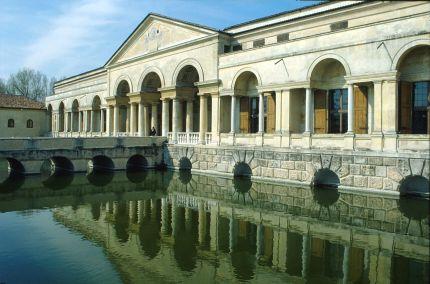Gonzaga domains in Mantova and Sabbioneta
 In July 2008, the Lombard city of Mantova and the nearby municipality of Sabbioneta were included in the list of UNESCO World Heritage Sites, a prestigious recognition for the artistic and urban treasures of these centres which stand out as important points of reference for the Italian and European Renaissance culture.
In July 2008, the Lombard city of Mantova and the nearby municipality of Sabbioneta were included in the list of UNESCO World Heritage Sites, a prestigious recognition for the artistic and urban treasures of these centres which stand out as important points of reference for the Italian and European Renaissance culture.
Both ruled by the Gonzaga family, the lords of Mantova who between 1400 and 1500 imposed themselves all over Europe as great patrons of the arts and leaders of mercenary companies, Mantova and Sabbioneta gather some of the most prestigious monuments dating back to the Renaissance Age. Buildings, works of art and town layouts were realized by the most acclaimed exponents of the Italian culture and art of that period, who between the XV and the XVI century lived in the court of the Gonzaga family.
Mantova's most representative landmark is the huge architectural complex of the Ducal Palace. Sumptuous buildings which are connected by means of long corridors and open galleries and are separated by elegant inner courtyards, gardens and squares constitute one of the largest courts in Europe. With the exception of the original core of the complex, the so-called Old Court, which includes Palazzo del Capitano and Magna Domus and has dominated Piazza Sordello since the XIII century, the huge palace of the Gonzaga family was started by architect Luca Fancelli and concluded by Giovan Battista Bertani between ‘400 and ‘500 and still keeps attracting large numbers of visitors.
Apart from the sumptuous rooms frescoed by Pisanello and the Room of Isabella d’Este situated in the Old Court, not be missed are the Room of Tapestries, the Room of Rivers and the Room of Zodiac.The defensive bulwark of the complex, the Castle of St. Giorgio, which had been part of the original core since the late ‘300, was turned into the residence of the Gonzaga Family in the mid ‘400.
Inside the castle, Andrea Mantegna frescoed the famous Room of the Bride and Bridegroom, one of the most appreciated rooms of the whole complex. Walking across the New Court, which was realized between 1480 and 1484, visitors will have the opportunity to admire well-preserved rooms and furnishings. Not to be missed are the charming courtyards and gardens and the Palatine Church of St. Barbara. 
Next stop could be Palazzo Te, a monumental residence commissioned by Federico II Gonzaga and realized by the architect and painter Giulio Romano. Its name derives from Tejeto, the original name of its location which is situated just outside the ancient old town.
Today, the palace hosts Mantova's Civic Museum and the International Centre of Art and Culture. It boasts original architectures and decorations which were all designed and realized by Giulio Romano and his pupils.
Among the most famous rooms are the Room of Giants, the Room of Love and Psyche, the Room of Eagles and the Room of Sun, which are all embellished by precious stuccos, paintings and frescoes depicting pagan symbols. They symbolize the political power of the Duke and his love for Isabella Boschetto, the latter being often portrayed wearing mythological clothing.
Other stunning places of interest are Palazzo San Sebastiano, which was the residence of Marchese Francesco II Gonzaga and is now the seat of the City Museum, Palazzo Valenti Gonzaga, which was repeatedly renovated but still retains its original fascination, and some of the most important religious buildings of Mantova's old town, such as the Duomo, the Church of St. Francesco and the Church of St. Maria della Vittoria, the latter being built by the most important artists and architects of that age.
The lovely town of Sabbioneta is situated 30 kilometres far from Mantova in the direction of Parma. Situated just in the heart of the Po Valley, this charming centre was founded in 1500 by Vespasiano Gonzaga Colonna, who appointed himself Duke of Sabbioneta, the Renaissance ideal city. The project of Vespasiano was realized in thirty-five years, from 1556 to 1591.
The city, which had become an impressive fortress and a strategic crossroads for trade and communications since the second half of 1500, was subsequently enriched with a Ducal Palace, the so-called Palazzo Grande, a Theatre, a Garden Palace, which was dedicated to the recreational activities of the ducal court, and the so-called Galleria degli Antichi or Corridor Grande, where the duke hosted his collection of ancient marbles and hunting throphies.
Among the most beautiful religious buildings are the Church of Incoronata, the Church of Assunta and the Church of Carmine. Most artistic treasures which embellished churches and palaces in 1500 are now hosted inside Sabbioneta's Museum of Sacred Art, which also contains coats of arms and decorations which belonged to the Duke of Sabbioneta. Sabbioneta's events and festivals, which are aimed at recollecting past fascination, attract large numbers of visitors and give them the opportunity to visit the province of Mantova and discover the vicissitudes experienced by the powerful Gonzaga Family.
- Transport Milan
- Lecco: naturalistic itineraries
- Park of Southern Adda in Lodi
- Gonzaga domains in Mantova and Sabbioneta
- Milan: old town
- Campione d'Italia, history and Casino
- Stradivari Itinerary across Cremona
- Pavia's Charterhouse
- Sondrio: wines and local staples
- Varese's Sacro Monte and Regional Park
- Bergamo's Palaeontological Park
- Franciacorta Wine Route and Lake Iseo
- Brianza Lakes
- Monza's Circuit & Grandprix





